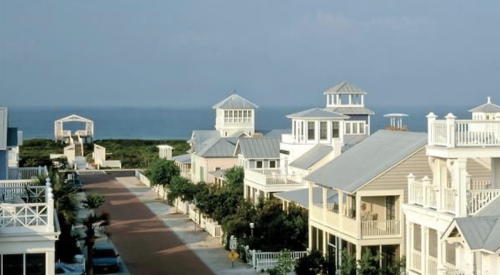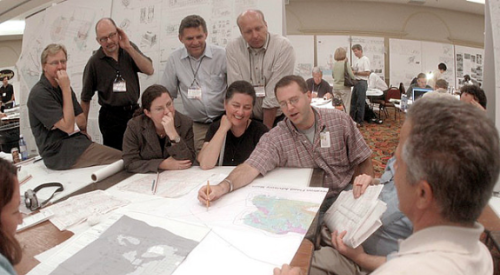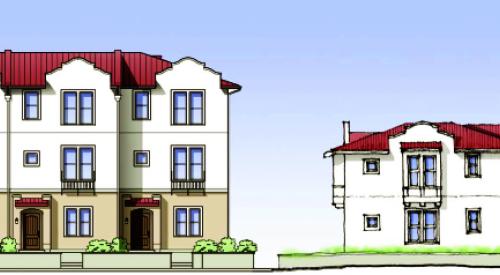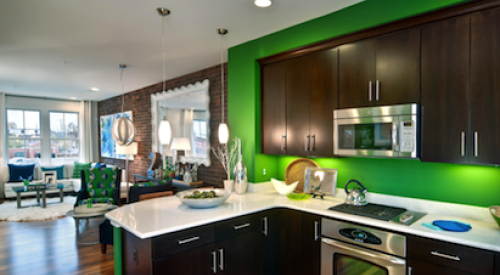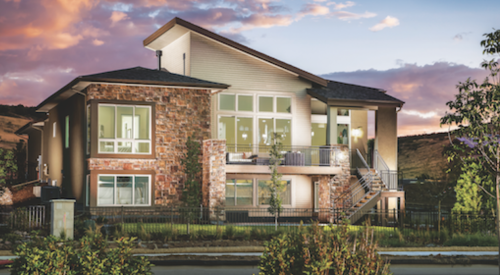|
If you think Andres Duany and Elizabeth Plater-Zyberk are interested only in peppering the landscape with re-created 19th century villages, guess again. First, look at plans for Aqua, a modernist neighborhood the planners designed for Dacra Development on 8.5 acres at the tip of Allison Island in Miami Beach, Fla. Then listen as they discuss the housing products they believe 21st century America demands.
Developer Craig Robins describes Aqua as a high-density merger of traditional urbanism with modern architecture. Plater-Zyberk, who is also dean of the School of Architecture at the University of Miami, led the design of a master plan with a network of tree-lined streets and squares, a waterfront pedestrian promenade, convenience stores, office space, public meeting rooms, a health club, swimming pools and boat docks. New York and Miami architects are designing the homes and other buildings in a variety of modernist styles. The residences will be in three midrise apartment buildings and 46 detached single-family homes, with prices ranging from $350,000 to $3 million.
“Aqua has a street-and-block pattern that concerns itself with the public space,” Plater-Zyberk says. “We could have done a loop road, like some other islands have, to access the homes. But Aqua has a small square, and we made a point of putting a street along the water’s edge to place those water views in the public realm. This is really a microcosm of all our New Urbanist beliefs.”
Robins, a prominent figure in the re-emergence of Miami Beach’s Art Deco District, says the master plan “leaves room for diversity and individuality” in the homes. That might be true, but there’s nothing here that looks like Seaside or Kentlands.
“Aqua breaks the mold of what many people perceive TND to be,” Duany says, “but that’s a misconception. New Urbanism is not style-based. Aqua makes that clear.”
Not even Aqua, however, goes where Plater-Zyberk and Duany believe housing design is headed. “From now on, every home built in America should be a live/work unit,” Duany says. “That’s the new reality that computers, modems and the Internet have led us to, but the housing industry is missing it entirely.”
While builders have been including home offices in their houses for some time, Duany and Plater-Zyberk believe a far greater variety of work-space types is needed to meet the different demands of the various market segments. “We need starter live/works for people right out of school,” Duany says. “We need move-up live/works for serious midlife businesses and retirement live/works for people who will never really retire. We also need live/works for blue-collar trades, people who do mechanical things. All of these uses require subtle differences in zoning. But our zoning now treats all work as if it were a 19th century factory belching smoke.”
| “Every housing unit we design from now on will be a live/work. We can sell this all day long.” |
Duany says the extreme demand for home work spaces with varying degrees of public access will soon drive a revolution in zoning and building codes. “They will eventually be nuanced to tell the difference between noisy, industrial uses and today’s information-age workplaces, which neighbors don’t even notice,” he says. “And there’s no reason to require a two-hour fire separation when all we’re using is computers. Cars and kitchens are more dangerous than today’s home offices.”
Duany and Plater-Zyberk believe the most critical nuance to drive into new building and zoning codes is a gradient that allows people to choose to live in places where there are different degrees of public access to the live/work units. “If you just have home offices with no public access, you would have a very quiet neighborhood,” Duany says. “In offices where you have employees also using the space, but no customers, you’d have a moderately active neighborhood. The most active would be a neighborhood with the kind of work spaces most people now associate with the live/ work concept, where you have both employees and customers coming and going.”
He believes there’s no stopping these changes, which will be driven by demand. But he sees big profits for the first builders to market communities on the basis of live/work capability.
“What makes this so exciting is that we’re finally going to address the forgotten aspect of the American dream — being your own boss,” Duany says. “The housing industry has been selling the little house on the prairie for decades but ignoring the be-your-own-boss aspect of the dream. Today we have an opportunity with live/work units to sell that second half of the American dream. Every housing unit we design from now on will be a live/work. We can sell this all day long.”
However, says Duany, today’s public processes are incompatible with the kind of neighborhoods we need to build. “For instance, when you have so many people working at home in relative isolation, we need neighborhoods with social centers to replace the workplace as a point of social interaction. If you work at home, you need to be able to stroll to the neighborhood social center at lunch to get a people fix and visit the local Kinko’s.
“However, the NIMBY [not in my back yard] forces will fight this every step of the way. They fear the impact of density, mixed-use and connectivity of streets on their property values. We need to understand their point of view. When density is an apartment block with 800 units and a parking garage, it fulfills the worst expectations of neighbors. If mixed-use means a strip mall or a convenience store, of course they’ll fight it. Same with connectivity if it takes the form of a high-speed collector road. The building industry is ruining its reputation by building those things. The whole of society is marshaling itself to stop development, even though society desperately needs it. But New Urbanism can overcome all of these fears. We can turn builders into the good guys.”
It will be interesting to watch Duany and Plater-Zyberk work during the next 10 years to see how much progress New Urbanism makes, especially on the live/ work front. “It’s our number one priority,” Duany says.
